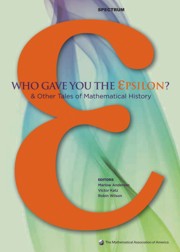Book contents
- Frontmatter
- Introduction
- Contents
- Analysis
- Geometry, Topology and Foundations
- Foreword
- Gauss and the Non-Euclidean Geometry
- History of the Parallel Postulate
- The Rise and Fall of Projective Geometry
- Notes on the History of Geometrical Ideas
- A note on the history of the Cantor set and Cantor function
- Evolution of the Topological Concept of “Connected”
- A Brief, Subjective History of Homology and Homotopy Theory in this Century
- The Origins of Modern Axiomatics: Pasch to Peano
- C. S. Peirce's Philosophy of Infinite Sets
- On the Development of Logics between the two World Wars
- Dedekind's Theorem:√2 × √3 = √6
- Afterword
- Algebra and Number Theory
- Surveys
- Index
- About the Editors
Gauss and the Non-Euclidean Geometry
from Geometry, Topology and Foundations
- Frontmatter
- Introduction
- Contents
- Analysis
- Geometry, Topology and Foundations
- Foreword
- Gauss and the Non-Euclidean Geometry
- History of the Parallel Postulate
- The Rise and Fall of Projective Geometry
- Notes on the History of Geometrical Ideas
- A note on the history of the Cantor set and Cantor function
- Evolution of the Topological Concept of “Connected”
- A Brief, Subjective History of Homology and Homotopy Theory in this Century
- The Origins of Modern Axiomatics: Pasch to Peano
- C. S. Peirce's Philosophy of Infinite Sets
- On the Development of Logics between the two World Wars
- Dedekind's Theorem:√2 × √3 = √6
- Afterword
- Algebra and Number Theory
- Surveys
- Index
- About the Editors
Summary
A Review of Gauss's Werke, Vol. VII
We are so accustomed to the German professor who does, we hardly expect the German professor who does not. Such, however, was Schering of Göttingen, who so long held possession of the papers left by Gauss.
Schering had planned and promised to publish a supplementary volume, but never did, and only left behind him at his death certain preparatory attempts thereto, consisting chiefly of excerpts copied from the manuscripts and letters left by Gauss. Meantime these papers for all these years were kept secret and even the learned denied all access to them.
Schering dead, his work has been quickly and ably done, and here we have a stately quarto [1] of matter supplemental to the first three volumes, and to the fourth volume with the exception of the geodetic part.
Of chief interest for us is the geometric portion (pp. 159–452), edited by just the right man, Professor Stäckel of Kiel.
One of the very greatest discoveries inmathematics since ever the world began is, beyond peradventure, the non-Euclidean geometry. Bywhom was this given to the world in print? By a Hungarian, John Bolyai, who made the discovery in 1823, and by a Russian, Lobachevski, who had made the discovery by 1826. Were either of these men prompted, helped, or incited by Gauss, or by any suggestion emanating from Gauss? No, quite the contrary.
- Type
- Chapter
- Information
- Who Gave You the Epsilon?And Other Tales of Mathematical History, pp. 115 - 119Publisher: Mathematical Association of AmericaPrint publication year: 2009

